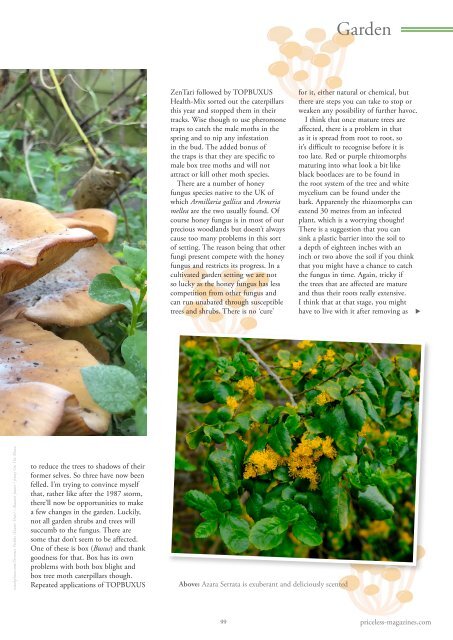Wealden Times | WT260 | January 2024 | Good Living Supplement inside
The lifestyle magazine for Kent & Sussex - Inspirational Interiors, Fabulous Fashion, Delicious Dishes
The lifestyle magazine for Kent & Sussex - Inspirational Interiors, Fabulous Fashion, Delicious Dishes
Create successful ePaper yourself
Turn your PDF publications into a flip-book with our unique Google optimized e-Paper software.
Garden<br />
ZenTari followed by TOPBUXUS<br />
Health-Mix sorted out the caterpillars<br />
this year and stopped them in their<br />
tracks. Wise though to use pheromone<br />
traps to catch the male moths in the<br />
spring and to nip any infestation<br />
in the bud. The added bonus of<br />
the traps is that they are specific to<br />
male box tree moths and will not<br />
attract or kill other moth species.<br />
There are a number of honey<br />
fungus species native to the UK of<br />
which Armillaria gallica and Armeria<br />
mellea are the two usually found. Of<br />
course honey fungus is in most of our<br />
precious woodlands but doesn’t always<br />
cause too many problems in this sort<br />
of setting. The reason being that other<br />
fungi present compete with the honey<br />
fungus and restricts its progress. In a<br />
cultivated garden setting we are not<br />
so lucky as the honey fungus has less<br />
competition from other fungus and<br />
can run unabated through susceptible<br />
trees and shrubs. There is no ‘cure’<br />
for it, either natural or chemical, but<br />
there are steps you can take to stop or<br />
weaken any possibility of further havoc.<br />
I think that once mature trees are<br />
affected, there is a problem in that<br />
as it is spread from root to root, so<br />
it’s difficult to recognise before it is<br />
too late. Red or purple rhizomorphs<br />
maturing into what look a bit like<br />
black bootlaces are to be found in<br />
the root system of the tree and white<br />
mycelium can be found under the<br />
bark. Apparently the rhizomorphs can<br />
extend 30 metres from an infected<br />
plant, which is a worrying thought!<br />
There is a suggestion that you can<br />
sink a plastic barrier into the soil to<br />
a depth of eighteen inches with an<br />
inch or two above the soil if you think<br />
that you might have a chance to catch<br />
the fungus in time. Again, tricky if<br />
the trees that are affected are mature<br />
and thus their roots really extensive.<br />
I think that at that stage, you might<br />
have to live with it after removing as <br />
istockphoto.com/Terrence Pickles (Exeter Trees) / Alastair James / Jenny On The Moon<br />
to reduce the trees to shadows of their<br />
former selves. So three have now been<br />
felled. I’m trying to convince myself<br />
that, rather like after the 1987 storm,<br />
there’ll now be opportunities to make<br />
a few changes in the garden. Luckily,<br />
not all garden shrubs and trees will<br />
succumb to the fungus. There are<br />
some that don’t seem to be affected.<br />
One of these is box (Buxus) and thank<br />
goodness for that. Box has its own<br />
problems with both box blight and<br />
box tree moth caterpillars though.<br />
Repeated applications of TOPBUXUS<br />
Above: Azara Serrata is exuberant and deliciously scented<br />
99<br />
priceless-magazines.com

















